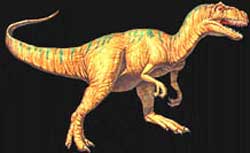Tales in stone
 Some say they never died, they simply flew away. Fearsome gigantic beasts that evolved into the myriad coloured birds we see around us today. Others are of the opinion that they were snuffed out by a hammer of the gods.
Some say they never died, they simply flew away. Fearsome gigantic beasts that evolved into the myriad coloured birds we see around us today. Others are of the opinion that they were snuffed out by a hammer of the gods.
Huge, mean and terrifying, they were cold-blooded lizards which were happily terrorising the entire planet, till one day, about 65 million years ago, a wayward meteor decided to end their reign. But they remain far from extinct. Through the years, they have been resurrected frequently enough to scare us through films, books and the occasional newspaper or magazine article. They are the dinosaurs, the "giant lizards', Jurassic rulers of an ancient Earth. And what do we know about them? Well, not much to write home about.
However, all that might change soon. Science now has a second chance to find out more about the dinosaurs, thanks to a 113-million-year old fossil found in Italy. Palaeontologists keep digging up fossils all the time; what is so special about this one? Well, for once, the fossils that experts have dug up so far were essentially fragmentary: only bones and vestiges of a few other organs. That's it. But this one is different. In this specimen, major portions of the animal's intestines, colon, liver, muscles, windpipe and other parts are relatively intact. These and other details of the animal's soft tissues have got the scientific community excited, since all these can tell us everything we wanted to know about the dinosaurs but did not know which fossil to ask.
According to the experts such as Michael J Benton, a palaeontologist at the University of Bristol, the position of the dinosaur's liver might prove vital. "The lungs are not preserved,' he said, "but the position of the liver might help us find out where the lungs were originally located. The primitive respiratory system of the present-day crocodiles differs significantly from that of the birds, which boast of a much more efficient system. This Italian fossil might tell us if the dinosaurs' breathing system was closer to that of the birds or the crocodiles.' And this can be of immense value to all palaeontologists, amidst whom there have been frequent arguments regarding the antecedents of these creatures. Some say that the dinosaurs were actually bird-like, while the rival school has been promoting the dinosaurs-were-lizards-and-there-is-nothing-more-to-it theory. "This particular animal's intestine was shorter than what might have been expected, so it presumably processed food very efficiently,' Benton said.
The fossil is not new, in fact, it was first unearthed over a decade ago. But it was only last month that re-examination by two palaeontologists
